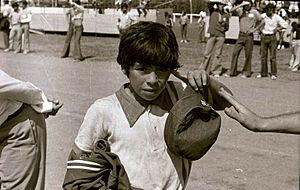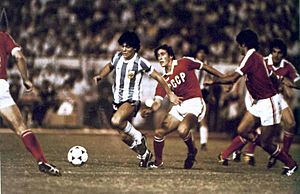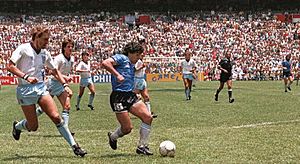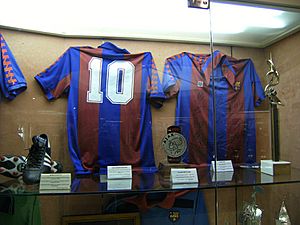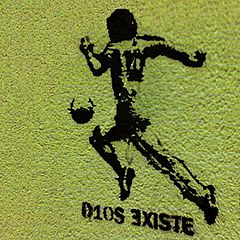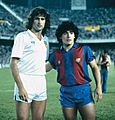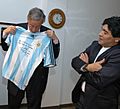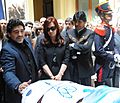Diego Maradona facts for kids
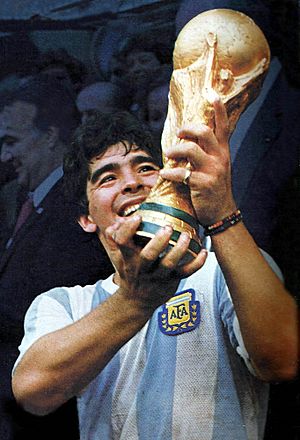
Maradona after winning the 1986 FIFA World Cup with Argentina
|
|||||||||||||||||||||||||||||||||||||||||||
| Personal information | |||||||||||||||||||||||||||||||||||||||||||
|---|---|---|---|---|---|---|---|---|---|---|---|---|---|---|---|---|---|---|---|---|---|---|---|---|---|---|---|---|---|---|---|---|---|---|---|---|---|---|---|---|---|---|---|
| Full name | Diego Armando Maradona | ||||||||||||||||||||||||||||||||||||||||||
| Date of birth | 30 October 1960 | ||||||||||||||||||||||||||||||||||||||||||
| Place of birth | Lanús, Argentina | ||||||||||||||||||||||||||||||||||||||||||
| Date of death | 25 November 2020 (aged 60) | ||||||||||||||||||||||||||||||||||||||||||
| Place of death | Dique Luján, Argentina | ||||||||||||||||||||||||||||||||||||||||||
| Height | 1.65 m (5 ft 5 in) | ||||||||||||||||||||||||||||||||||||||||||
| Position(s) | Attacking midfielder, second striker | ||||||||||||||||||||||||||||||||||||||||||
| Youth career | |||||||||||||||||||||||||||||||||||||||||||
| 1969–1976 | Argentinos Juniors | ||||||||||||||||||||||||||||||||||||||||||
| Senior career* | |||||||||||||||||||||||||||||||||||||||||||
| Years | Team | Apps | (Gls) | ||||||||||||||||||||||||||||||||||||||||
| 1976–1981 | Argentinos Juniors | 166 | (116) | ||||||||||||||||||||||||||||||||||||||||
| 1981–1982 | Boca Juniors | 40 | (28) | ||||||||||||||||||||||||||||||||||||||||
| 1982–1984 | Barcelona | 36 | (22) | ||||||||||||||||||||||||||||||||||||||||
| 1984–1991 | Napoli | 188 | (81) | ||||||||||||||||||||||||||||||||||||||||
| 1992–1993 | Sevilla | 26 | (5) | ||||||||||||||||||||||||||||||||||||||||
| 1993–1994 | Newell's Old Boys | 5 | (0) | ||||||||||||||||||||||||||||||||||||||||
| 1995–1997 | Boca Juniors | 30 | (7) | ||||||||||||||||||||||||||||||||||||||||
| Total | 491 | (259) | |||||||||||||||||||||||||||||||||||||||||
| International career | |||||||||||||||||||||||||||||||||||||||||||
| 1977–1979 | Argentina U20 | 15 | (8) | ||||||||||||||||||||||||||||||||||||||||
| 1977–1994 | Argentina | 91 | (34) | ||||||||||||||||||||||||||||||||||||||||
| Managerial career | |||||||||||||||||||||||||||||||||||||||||||
| 1994 | Deportivo Mandiyú | ||||||||||||||||||||||||||||||||||||||||||
| 1995 | Racing Club | ||||||||||||||||||||||||||||||||||||||||||
| 2008–2010 | Argentina | ||||||||||||||||||||||||||||||||||||||||||
| 2011–2012 | Al-Wasl | ||||||||||||||||||||||||||||||||||||||||||
| 2013–2017 | Deportivo Riestra (assistant) | ||||||||||||||||||||||||||||||||||||||||||
| 2017–2018 | Fujairah | ||||||||||||||||||||||||||||||||||||||||||
| 2018–2019 | Dorados de Sinaloa | ||||||||||||||||||||||||||||||||||||||||||
| 2019–2020 | Gimnasia de La Plata | ||||||||||||||||||||||||||||||||||||||||||
|
Medal record
|
|||||||||||||||||||||||||||||||||||||||||||
| *Club domestic league appearances and goals | |||||||||||||||||||||||||||||||||||||||||||
Diego Armando Maradona (October 30, 1960 – November 25, 2020) was an Argentine professional football player and manager. Many people consider him one of the greatest players in the history of the sport. Maradona was one of two winners of the FIFA Player of the 20th Century award.
Maradona was known as "El Pibe de Oro" which means "The Golden Boy". This nickname stayed with him throughout his amazing career. He famously wore the number 10 jersey.
Maradona was the first player to break the world record transfer fee twice. In 1982, he moved to Barcelona for £5 million. Then, in 1984, he joined Napoli for £6.9 million. He played for several clubs, including Argentinos Juniors, Boca Juniors, Barcelona, Napoli, Sevilla, and Newell's Old Boys. He is most famous for his time at Napoli, where he helped the team win many important titles.
For his country, Argentina, he played 91 games and scored 34 goals. Maradona played in four FIFA World Cups. In the 1986 World Cup in Mexico, he was the captain. He led Argentina to victory over West Germany in the final. He also won the Golden Ball as the best player of that tournament.
In the 1986 World Cup quarter-final, he scored two goals in a 2–1 win against England. These goals became famous for different reasons. The first goal was an uncalled foul, known as the "Hand of God". The second goal was a fantastic 60 m (66 yd) dribble past five England players. FIFA.com voters later chose it as the "Goal of the Century".
Maradona later became the coach of Argentina's national football team in 2008. He led the team in the 2010 World Cup in South Africa. After that, he coached clubs like Al Wasl in Dubai and Fujairah. From 2018 to 2019, he coached Mexican club Dorados. He was the coach of Gimnasia de La Plata in Argentina until his death in 2020.
Contents
Early Life and Football Dreams
Diego Armando Maradona was born on October 30, 1960. He was born in Lanús, Buenos Aires Province, Argentina. His family was not rich and had moved from Corrientes Province.
He grew up in Villa Fiorito, a poor neighborhood on the edge of Buenos Aires. Diego was the first son, with four older sisters. He also had two younger brothers, Hugo and Raúl, who also became professional football players. His father worked in a chemicals factory.
When Diego came to Argentinos Juniors for trials, I was really struck by his talent and couldn't believe he was only eight years old. In fact, we asked him for his ID card so we could check it, but he told us he didn't have it on him. We were sure he was having us on because, although he had the physique of a child, he played like an adult. When we discovered he'd been telling us the truth, we decided to devote ourselves purely to him.
Maradona got his first football as a gift when he was three years old. He quickly fell in love with the game. At age eight, a talent scout noticed him playing for his local club, Estrella Roja. In 1969, he joined Los Cebollitas (The Little Onions). This was the junior team of Argentinos Juniors in Buenos Aires. His friend Gregorio Carrizo had already been picked by coach Francis Gregorio Cornejo.
Maradona became a star for the Cebollitas. When he was 12, he would entertain fans by showing off his ball skills during halftime breaks. From 1973 to 1974, Maradona led the Cebollitas to two tournament wins. They also had an amazing streak of 141 undefeated games in a row. This team is seen as the best youth team in Argentine football history. Maradona looked up to Brazilian player Rivellino and Manchester United winger George Best.
Playing for Clubs
Starting in Argentina
On October 20, 1976, Maradona made his professional debut for Argentinos Juniors. He was just 10 days shy of his 16th birthday. He wore the number 16 jersey and became the youngest player in the Argentine Primera División.
Maradona scored his first goal in the Primera División on November 14, 1976. This was two weeks after he turned 16.
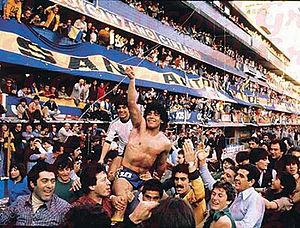
Maradona played for Argentinos Juniors for five years, from 1976 to 1981. He scored 115 goals in 167 games. Then, he moved to Boca Juniors for US$4 million.
He signed with Boca Juniors on February 20, 1981. His first game was two days later against Talleres de Córdoba. He scored twice in a 4–1 win for Boca. Boca Juniors had a great season and won the league title. This was the only league title Maradona won in Argentina.
Playing in Barcelona
"He had complete mastery of the ball. When Maradona ran with the ball or dribbled through the defence, he seemed to have the ball tied to his boots. I remember our early training sessions with him: the rest of the team were so amazed that they just stood and watched him. We all thought ourselves privileged to be witnesses of his genius."
After the 1982 World Cup, Maradona moved to Barcelona in Spain. This transfer in June was a world record fee of £5 million. In 1983, with coach César Luis Menotti, Barcelona and Maradona won the Copa del Rey. They beat Real Madrid in the final. They also won the Spanish Super Cup against Athletic Bilbao. On June 26, 1983, Barcelona won against Real Madrid in El Clásico. Maradona scored in that match and was applauded by the rival Real Madrid fans.
Time at Napoli
Maradona then moved to Napoli in Italy. This was another world record fee, £6.9 million. He was introduced as a Napoli player on July 5, 1984. An amazing 75,000 fans welcomed him at the Stadio San Paolo.
At Napoli, Maradona played his best football. He quickly became the team's captain and a beloved star among the fans. He helped the team have the most successful period in its history. With Maradona leading, Napoli won their first ever Serie A Italian Championship in 1986–87.
Napoli won their second league title in 1989–90. They also finished second in the league twice. Other trophies Maradona won with Napoli include the Coppa Italia in 1987. They also won the UEFA Cup in 1989 and the Italian Supercup in 1990.
After the 1990 World Cup, Maradona faced some difficulties from local fans. This was because Argentina beat Italy in a semi-final match at Napoli's stadium. In 2000, Napoli officially retired the number 10 jersey in his honor. On December 4, 2020, after Maradona's death, Napoli's home stadium was renamed Stadio Diego Armando Maradona.
Later Career Clubs
Maradona left Napoli in 1992. He signed with Sevilla in Spain and played there for one year. In 1993, he played for Newell's Old Boys. In 1995, he returned to Boca Juniors for two years.
Maradona also played in some special matches. He played for Tottenham Hotspur in a testimonial game in 1986. In 1996, he played a friendly match with his brother Raul for Toronto Italia. In 2000, he captained Bayern Munich in a friendly. Maradona himself had a testimonial match in November 2001.
Playing for Argentina
For the Argentina national team, Maradona scored 34 goals in 91 games. He played his first international game at age 16 against Hungary in 1977. Coach César Luis Menotti did not pick him for the 1978 World Cup because he was too young.
At age 18, Maradona played in the 1979 FIFA World Youth Championship in Japan. He was the star of the tournament, scoring six goals. Argentina won the final 3–1 against the Soviet Union. In 1979, he scored his first senior international goal against Scotland.
Maradona and Lionel Messi are the only players to win the Golden Ball at both the FIFA U-20 World Cup and FIFA World Cup. Maradona won in 1979 and 1986. Messi did the same in 2005 and 2014 (and again in 2022).
World Cup Appearances
Maradona played in his first World Cup tournament in 1982. He captained the Argentine team to victory in the 1986 World Cup in Mexico. They won the final in Mexico City against West Germany.
He scored two famous goals in the 2–1 quarter-final win against England. The first goal was scored with his hand, which he later called "a little with the head of Maradona and a little with the hand of God". This became known as the "Hand of God". Maradona later admitted he purposely hit the ball with his hand.
Maradona's second goal, just four minutes after the "Hand of God" goal, was voted the greatest goal in World Cup history by FIFA. He ran more than half the field, dribbling past five English players. He then tricked the goalkeeper and scored. This goal was voted "Goal of the Century" in a 2002 FIFA online poll.
During the 1986 tournament, Maradona was incredible. He was involved in more than half of Argentina's shots. He attempted 90 dribbles, which was three times more than any other player. He was fouled a record 53 times. Maradona scored or helped with 10 of Argentina's 14 goals. This included the pass for the winning goal in the final. He won the Golden Ball as the best player of the tournament. Many believed he almost won the World Cup by himself. Zinedine Zidane, who watched the 1986 World Cup at 14, said Maradona "was on another level". A statue of him scoring the "Goal of the Century" was placed at the entrance of Azteca Stadium.
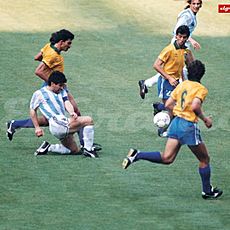
Maradona was captain again in the 1990 World Cup in Italy. Argentina reached another World Cup final. In the final in Rome, Argentina lost 1–0 to West Germany. The only goal was a penalty scored by Andreas Brehme.
At the 1994 World Cup in the United States, Maradona played only two games. He scored one goal against Greece. He was then sent home after failing a doping test.
Awards and Tributes
In 1990, the Konex Foundation in Argentina gave him the Diamond Konex Award. This is a very important cultural award in Argentina. It recognized him as the most important sports person in his country over the last decade.
In 2000, Maradona wrote his autobiography called Yo Soy El Diego ("I am The Diego"). It became a best-seller in Argentina.
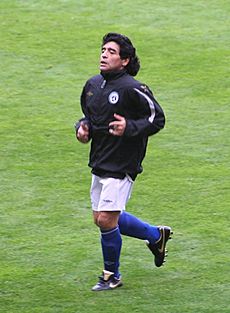
In 2000, he won the FIFA Player of the Century award. This award was decided by votes on FIFA's website, their magazine, and a jury. Maradona won the online poll with 53.6% of the votes.
Maradona has topped many fan polls. In a 2002 FIFA poll, his second goal against England was chosen as the best goal ever scored in a World Cup. He also received the most votes for the All-Time Ultimate World Cup Team.
On March 22, 2010, The Times newspaper in London named Maradona number 1 in 'The Greatest 10 World Cup Players of All Time'.

In 2008, Serbian filmmaker Emir Kusturica made a documentary about Maradona's life called Maradona.
Coaching Career
Club Coaching
Maradona started his coaching career with his former teammate Carlos Fren. In May 2011, he became the manager of Dubai club Al Wasl FC in the United Arab Emirates. He left the club in July 2012. In August 2013, Maradona became a 'spiritual coach' at Argentine club Deportivo Riestra. In May 2018, he was announced as the new chairman of Belarusian club Dynamo Brest. In September 2018, he was appointed manager of Mexican second division team Dorados. He won his first game with Dorados 4–1. In June 2019, he stepped down from the role due to health reasons. On September 5, 2019, Maradona became the new head coach of Gimnasia de La Plata. He signed a contract until the end of the season. He briefly left the club but rejoined two days later. He was still coaching Gimnasia de La Plata when he passed away in November 2020.
National Team Coaching
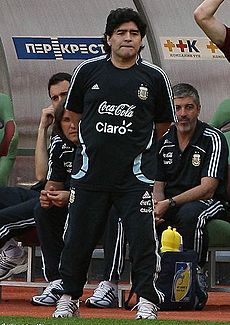
On October 29, 2008, Maradona was confirmed as the head coach of the Argentina national team. His first game as coach was a 1–0 win against Scotland in Glasgow.
After winning his first three matches, his team lost 6–1 to Bolivia. With two games left in the qualification tournament for the 2010 World Cup, Argentina was in danger of not qualifying. However, they won their last two matches and secured their spot in the finals.
At the World Cup, Argentina beat Mexico 3–1. But then, they lost badly to Germany 4–0 in the quarter-finals. After this defeat, Maradona thought about leaving his coaching role. On July 27, the Argentine Football Association decided not to renew his contract.
Personal Life
Family Life
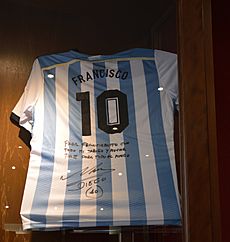
Maradona married his long-time girlfriend Claudia Villafañe on November 7, 1989, in Buenos Aires. They had two daughters, Dalma Nerea (born in 1987) and Gianinna Dinorah (born in 1989). Gianinna later married footballer Sergio Agüero and they had a son, making Maradona a grandfather in 2009.
Maradona and Villafañe divorced in 2004. After the divorce, Claudia became a theater producer. Dalma pursued an acting career.
Maradona's great-nephew Hernán López is also a professional footballer.
His Passing
On November 2, 2020, Maradona was admitted to a hospital in La Plata. A day later, he had emergency brain surgery for a blood clot.
He was released on November 12 after a successful surgery. Doctors continued to supervise him. On November 25, at the age of 60, Maradona suffered a cardiac arrest and passed away in his sleep. This happened at his home in Dique Luján, Buenos Aires Province, Argentina. Maradona was buried next to his parents in the Jardín de Bella Vista cemetery.
Maradona in Culture
In Argentina, Maradona is seen as a huge icon. People often talk about him like a legend.
Maradona appeared in many Argentine comic books. There was even a short-lived comic book called El Die, where Maradona was the main character.
There are also online games dedicated to Maradona. In Rosario, Argentina, some locals created the "Church of Maradona". This group uses elements from Christian traditions but changes them to reflect details about Maradona. It started with 200 members, and many more joined online.
Many Argentine artists have made songs to honor Diego. Some famous ones include "La Mano de Dios" by El Potro Rodrigo and "Maradona" by Andrés Calamaro. There are also films like Maradona, La Mano de Dios and Maradona by Kusturica. In March 1981, the band Queen met Maradona backstage during their concert in Argentina.
By 1982, Maradona was one of the biggest sports stars in the world. He had deals with many companies, like Puma and Coca-Cola. In 1982, he was in a World Cup commercial for Coca-Cola and a Japanese commercial for Puma. In 1984, a poll named Maradona the best-known person in the world. In 2010, he appeared in a commercial for Louis Vuitton with fellow World Cup winners Pelé and Zinedine Zidane. Maradona was also in the music video for the 2010 World Cup song "Waka Waka" by Shakira.

A 2006 TV commercial for Brazilian soft drink Guaraná Antarctica showed Maradona as a member of the Brazil national team. He wore their yellow jersey and sang the Brazilian national anthem. This caused some talk in Argentina, even though the commercial wasn't meant for them. Maradona said he didn't mind wearing the Brazilian jersey, but he would never wear the shirt of River Plate, Boca Juniors' rival. Some Brazilians have even been named after Maradona, like footballer Diego Costa.
In 2017, Maradona was featured as a legendary player in the football video games FIFA 18 and Pro Evolution Soccer 2018. In 2019, a documentary film called Diego Maradona was released. It was made by Academy Award and BAFTA Award winning filmmaker Asif Kapadia. Kapadia said Maradona was the third part of his film series about child geniuses and fame. He found Maradona's journey fascinating, with moments of amazing skill and drama. He saw Maradona as a leader who took his teams to the top.
Images for kids
-
The moment when Atlético de Bilbao defender Andoni Goikoetxea injured Maradona on 24 September 1983
-
Maradona with his fellow countryman Mario Kempes before a Barcelona match against Valencia
-
Maradona saluting the crowd at the Stadio San Paolo in Naples during his presentation on 5 July 1984
-
Maradona at the Foxboro Stadium in Massachusetts, going to do a drug test after playing v Nigeria, 25 June 1994
-
Viewed as one of the best dribblers in the game, Maradona (pictured on the ball against Belgium in 1986) would often go on runs against the opposition.
-
Maradona at the 2018 FIFA World Cup in Russia, where he was treated by paramedics after collapsing following Argentina's victory over Nigeria.
-
Maradona (right) presenting a signed jersey to the former President of Argentina Néstor Kirchner in December 2007
-
Maradona, then-president Cristina Fernández de Kirchner and Evo Morales, at the funeral of former President of Argentina Néstor Kirchner, 28 October 2010
-
Maradona (center) visiting Argentina's new president Alberto Fernández (right) in December 2019
-
Maradona (middle) with Queen during the rock band's 1981 South American tour
-
Maradona's Golden Foot award in "The Champions Promenade" on the seafront of the Principality of Monaco
See also
 In Spanish: Diego Maradona para niños
In Spanish: Diego Maradona para niños


